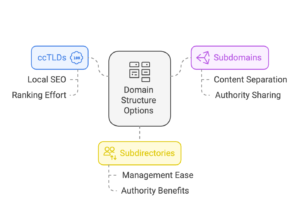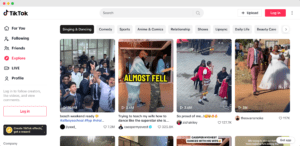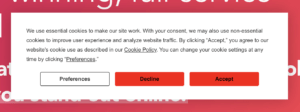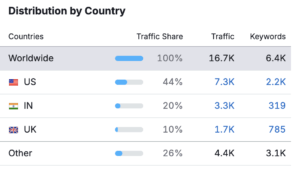
Expanding your business internationally sounds exciting—new markets, more customers, and bigger opportunities. But in reality, many businesses struggle to reach international customers effectively. What works in your home country might fall flat elsewhere due to language barriers, cultural differences, or simply not knowing where to start.
The good news? Digital marketing makes global expansion easier than ever. You don’t need a physical presence in another country to reach and convert customers there. With the right strategies—think international SEO, targeted ads, and localized content—you can connect with buyers worldwide without leaving your office.
In this guide, we’ll break down key tactics to help you attract and convert overseas customers. Whether you’re looking to test new markets or go all-in on global expansion, these strategies will give you a solid foundation to grow beyond borders.
What Is International Targeting?
International targeting in digital marketing refers to the strategies businesses use to reach customers outside their home country. Instead of relying solely on local audiences, brands can tap into global markets through SEO, paid ads, social media, and localized content.
But why should businesses consider expanding their reach? Simple—there’s a whole world of potential customers out there. Going international can open doors to higher revenue, brand recognition, and new growth opportunities. Plus, with digital tools making global marketing more accessible, it’s easier than ever to test and scale in different regions.
Of course, expanding internationally isn’t without challenges. Language barriers can make communication tricky, cultural differences can affect how your brand is perceived, and legal restrictions (like GDPR in Europe) can complicate marketing efforts. Understanding these hurdles upfront helps businesses create targeted, effective campaigns that resonate with international audiences.
SEO Strategy for Global Audiences
If you want your website to appear in international search results and in front of your target audience then you need to use SEO to help tell the search engine which particular country you’re targeting.
1. Use Hreflang Tags Correctly
Hreflang tags help search engines display the right language and regional version of your website to users. This prevents issues like duplicate content and ensures visitors land on the most relevant page based on their location.
2. Decide on Your URL Structure
There are three main ways to organize international websites:
- ccTLDs (country code top-level domains, e.g., example.fr) are best for businesses wanting a strong local presence but require more effort to rank.
- Subdomains (e.g., fr.example.com) keep content separate but still share authority with the main domain.
- Subdirectories (e.g., example.com/fr/) are easier to manage and benefit from the main domain’s SEO authority.

3. Conduct Country-Specific Keyword Research
Keywords that work in one country may not have the same search volume or intent elsewhere. Use local keyword research tools (like Google Keyword Planner, Ahrefs, or Semrush) to find relevant terms based on search behaviour in each target region.
4. Optimise for Google and Local Search Engines
While Google dominates globally, countries like China (Baidu), Russia (Yandex), and South Korea (Naver) have their own search engines. Understanding how these platforms rank websites (e.g., Baidu prefers .cn domains and Chinese-hosted sites) can improve visibility in those markets.
Paid Advertising for International Reach
Paid advertising is one of the fastest ways to reach international customers, but it requires a tailored approach to ensure your budget is spent effectively.
- Set up geo-targeted PPC campaigns: Platforms like Google Ads and Microsoft Ads let you target specific countries, cities, or even custom radius locations. Use this feature to show ads only in your target regions, preventing wasted ad spend on irrelevant audiences.
- Use location-based social media ads: Platforms like Meta (Facebook & Instagram), TikTok, and LinkedIn allow advertisers to target users based on location, language, and even cultural preferences. Adjust your messaging to fit local norms—what works in one country may not resonate in another.
- Adjust bids and budgets for different markets: Ad costs vary across regions. Some countries have higher competition and CPCs (cost-per-click), while others offer cheaper ad placements. Research local bidding trends and adjust your budget accordingly to maximize ROI.
- Localize your ad copy and landing pages: Even if your product or service remains the same, your messaging should align with local language, currency, and cultural references. A well-translated and culturally relevant ad can significantly improve conversions.
Social Media Strategies for Global Growth
Expanding your social media presence internationally isn’t as simple as translating your posts. Different regions have unique preferences, cultural norms, and even preferred platforms.
Tailor Content for Regional Audiences
What works in one country might fall flat in another. Cultural nuances, humour, and even emojis can be interpreted differently. To avoid missteps:
- Adjust tone and messaging to fit each market. A playful, casual tone may work in the U.S., while a more formal approach might be preferred in Japan.
- Use local slang, idioms, and references where appropriate.
- Consider time zones when scheduling posts to maximise engagement.
Localised Social Media Pages vs. a Single Global Page
Should you create separate accounts for each region or manage one global page? It depends on your business and audience:
- A single global page works well for brands with a consistent message across all markets. You can use Facebook’s location-based post targeting or Instagram’s multi-language captions to customise content.
- Localised pages are ideal if you’re targeting vastly different audiences with unique languages, promotions, and customer service needs. However, they require more resources to manage.
Partner with Local Influencers
Influencer marketing can be a powerful way to build trust in new markets, especially if your brand is unfamiliar to international customers.
- Work with influencers who have strong engagement within their country or niche.
- Ensure they align with your brand values and messaging.
- Allow them to create content in their own style—authenticity matters more than rigid brand guidelines.

A well-executed international social media strategy can help you break into new markets, build brand awareness, and drive sales—without needing a physical presence in every country.
Website Localisation & UX Best Practices
A seamless, localised website experience can make or break your success with international customers. Here’s how to ensure your site is optimised for a global audience:
Translating Content Effectively
Google Translate might work for quick translations, but it won’t cut it for a professional website. Poor translations can make your brand look untrustworthy. Instead:
- Use professional translators or AI-assisted translation tools with human review to translate your content into a different language.
- Adapt content for cultural nuances rather than just translating word-for-word.
- Localise visuals, including images, colours, and design elements, to match regional preferences.
Implementing Currency Converters & Region-Based Pricing
Nothing frustrates international customers more than seeing prices in a foreign currency. To improve conversions in the country you are targeting:
- Automatically display prices in the local currency based on the user’s location.
- Offer multiple payment options, including popular local payment methods (e.g., WeChat Pay in China, Klarna in Europe).
- Adjust pricing and promotions based on regional demand and purchasing power.
Optimising Site Speed for International Users
A slow website can drive users away, especially if they’re accessing it from a different country. Speed things up by:
- Using a Content Delivery Network (CDN) to distribute content across global servers.
- Hosting your website on regional servers for faster load times.
- Compressing images and minimising code to reduce page size.
Ensuring Compliance with Local Regulations
Different countries have different rules regarding data privacy, cookies, and user protection. To stay compliant:
- Implement GDPR-compliant cookie consent pop-ups for European users.
- Follow local data storage laws, especially in regions like China that have strict regulations.
- Clearly communicate terms, conditions, and refund policies based on regional requirements.

Email & Content Marketing for International Audiences
Reaching a global audience isn’t just about translating content—it’s about making sure your message truly connects with people in different regions.
One of the best ways to do this is by segmenting your email lists based on location and language. Sending the same email to everyone might seem efficient, but it often leads to low engagement. People respond better to content that feels relevant to them. By segmenting your audience by country, language, and even buying behaviour, you can personalise emails with offers, images, and messaging that resonate with each group. This approach not only improves open rates but also increases conversions.
Creating culturally relevant content is another key factor. What works in one country might not land well in another. Humour, references, and even colour choices can carry different meanings across cultures. Researching local customs and preferences helps businesses avoid awkward missteps and instead build stronger connections. Featuring region-specific testimonials, case studies, or product benefits can make international customers feel like your brand truly understands their needs. Visuals should also be adapted where possible, ensuring that the imagery reflects the diversity of your audience.
Timing plays a huge role in international marketing. Sending an email at 9 AM in New York means it could be landing in inboxes at 2 AM in London—not exactly prime time for engagement. Scheduling tools can help businesses send emails based on the recipient’s time zone, ensuring messages arrive when people are most likely to open them. The same principle applies to social media posts. Audiences in different regions have different peak engagement times, so staggering posts across multiple time zones can significantly improve reach and interaction.
How To Measure Success & Refine Your Strategy
Expanding into international markets isn’t a one-and-done effort—it requires constant tracking, testing, and adjusting. To understand what’s working (and what’s not), businesses need to measure performance across different regions using the right tools.
Use Google Analytics and other tracking tools
Google Analytics allows businesses to track key metrics like traffic, conversions, and user behaviour by country. By setting up location-based reports, you can see which markets are driving the most engagement and where potential customers might be dropping off. Tools like Google Search Console and Semrush can also provide insights into international search performance, showing how your site ranks in different countries.

A/B test content across different regions
What works for one audience might not work for another, so testing different versions of your content is essential. A/B testing landing pages, ad creatives, email subject lines, and even website layouts can show you what resonates best with each market. For example, a call-to-action that drives high conversions in the US might not perform the same way in Japan or Germany. Adjusting messaging, imagery, and even payment options based on test results can lead to better engagement and higher conversion rates.
Adapt based on international customer feedback
Data is important, but so is listening to actual customers. Gathering feedback through surveys, reviews, and social media interactions can uncover pain points that analytics alone won’t show. Maybe users in a certain country struggle with navigation due to language differences, or perhaps they prefer a different checkout method. Addressing these issues and refining your approach based on real user insights can make a huge difference in customer satisfaction and retention.
The International Targeting Report In GSC
The International Targeting report in Google Search Console was a tool that allowed website owners to specify which countries they wanted their content to be targeted to. This feature enabled users to set country-specific targeting for their pages, which could help Google serve your content to the right international audience.
However, Google has since deprecated this feature. While Google will still use hreflang tags to understand the language and regional variations of your content (and continue to support them), the country targeting option in Search Console has been removed. Google found that the country targeting feature didn’t provide enough value for the broader search ecosystem, leading to its discontinuation.
What does this mean for you?
- Hreflang tags remain essential: While you can no longer set country targeting via Search Console, using hreflang tags correctly is still crucial for telling Google which version of your page to serve to users in different countries and languages. This helps ensure the right content is displayed to the right audience.
- SEO adjustments: Without the country targeting feature, Google will rely even more on signals from hreflang tags and other SEO factors (such as content, backlinks, and local relevance) to determine the right audience for your pages. It’s important to have these elements set up correctly to maintain a strong international SEO strategy.
- Geo-targeting remains possible with paid ads: If you’re running paid ads, you can still target specific countries and regions through platforms like Google Ads, which gives you the ability to adjust your targeting based on location and language.
Expanding your business to target international audiences is an exciting step, but it’s not without its challenges. The good news is that with the right strategies—like international SEO, paid ads, localised content, and a smart social media game plan—you can break down barriers and connect with customers worldwide.
The main hurdle? Language and cultural differences, along with navigating the complexities of global regulations. But by understanding these pain points and addressing them with tailored, thoughtful marketing, you’ll find that reaching international audiences is not only possible but also highly rewarding.
So, don’t let the idea of expanding beyond borders overwhelm you. Start small, test new markets, and use the digital tools at your disposal to scale strategically. With the right approach, your business can thrive globally, opening up new avenues for growth and success.


